So many architects, so much time
San Miguel visitors can't miss the parish church, La
Parroquia, the in-your-face symbol of the town and perhaps
the most distinctive facade in all of Mexico. But often
they fail to realize that their impression of La Parroquia is
all facade. There is much more to this church than its
bizarre Gothic front. The next two pictures below show
much more of the heterogeneous exterior. (La Parroquia
is the church in the center including the left two domes and
the soaring pink facade.)
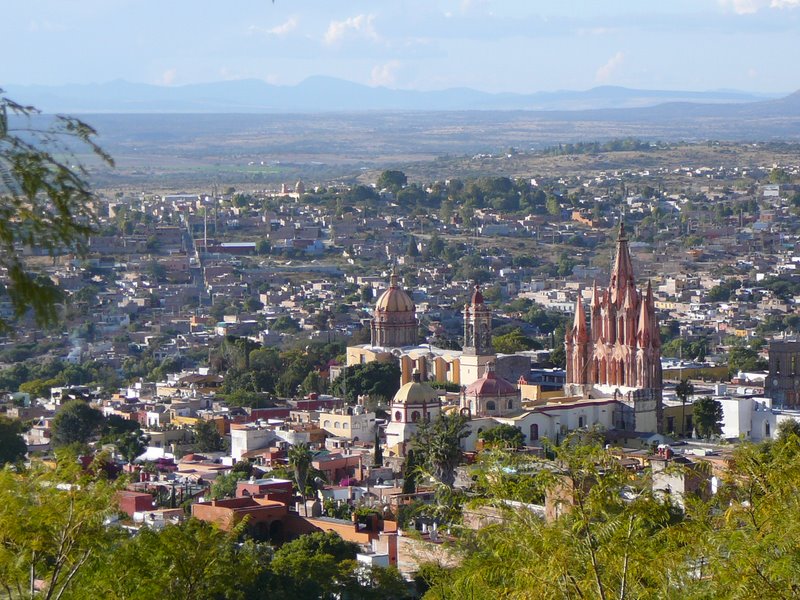
Here's another view taken from southwest of the
church. As both pictures show, the pseudo-Gothic
tower makes La Parroquia by far the tallest structure in this
hilly town. Since San Miguel became a National
Historical Monument in 1926, it's likely to remain that way.
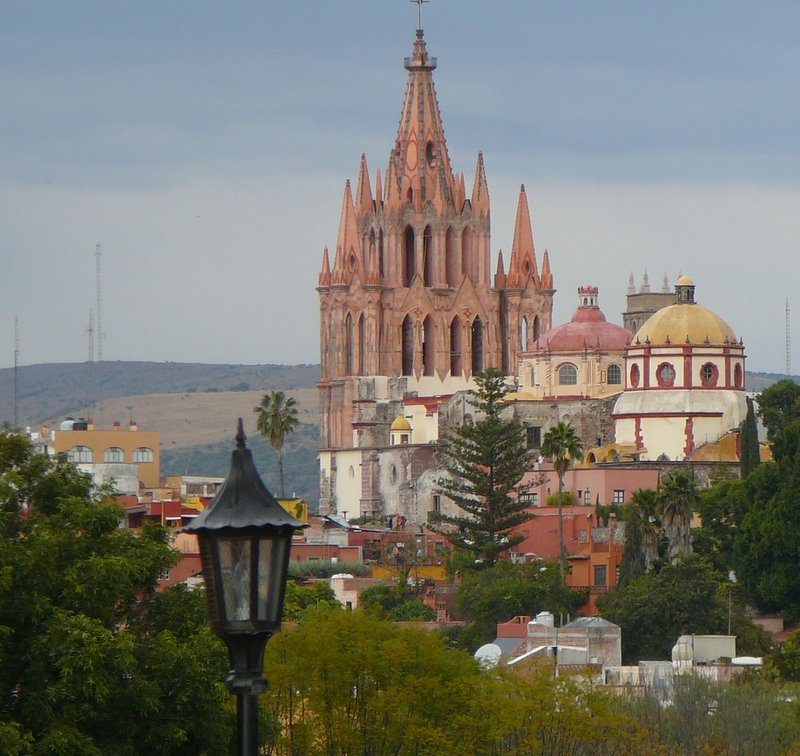
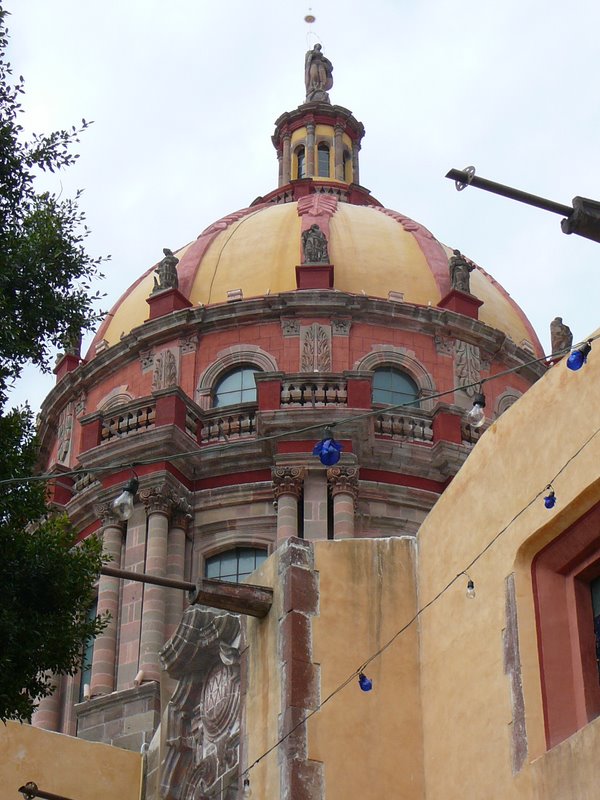
The two domes are most likely from the original 1683 church
although the nearer tower bears a suspicious resemblance
(maybe just a paint job?) to the tower of
Los Monjas,
the Church of the Immaculate Conception (thumbnail
photo on the right which can be enlarged by clicking on it).
Click here to
see more of Los Monjas church.
The earlier church was designed by architect Marco Antonio
Sobarias in pretty much the standard Latin cross
plan.
[218]
Here's a closer look at one of the
Parroquia's two domes:
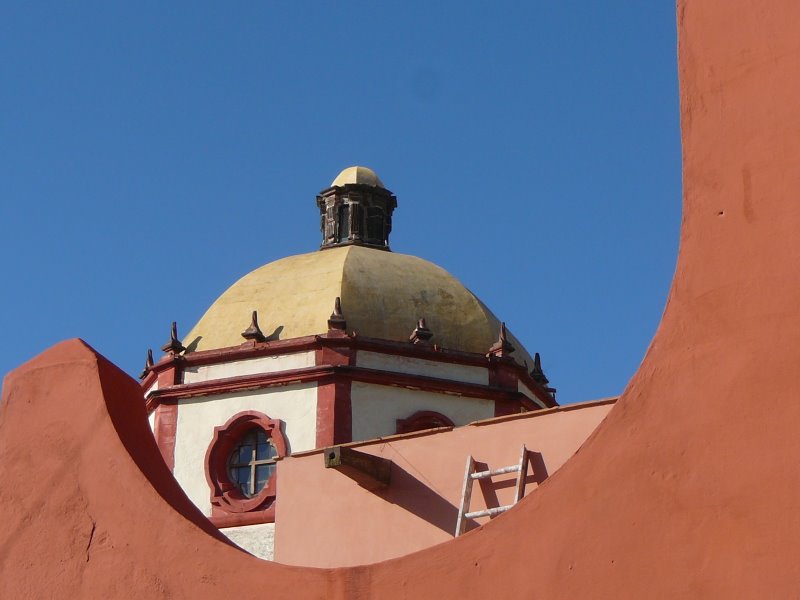
Two centuries after La Parroquia was built, Mexico's first
native-born bishop and San Miguel native ordered a new
facade. Rather than hiring a traditionally trained
architect, the local parish priest chose another San Miguel
native, Ceferino Gutierrez, a mason and builder, to create
what the untrained Gutierrez viewed to be a Gothic
structure
[12].
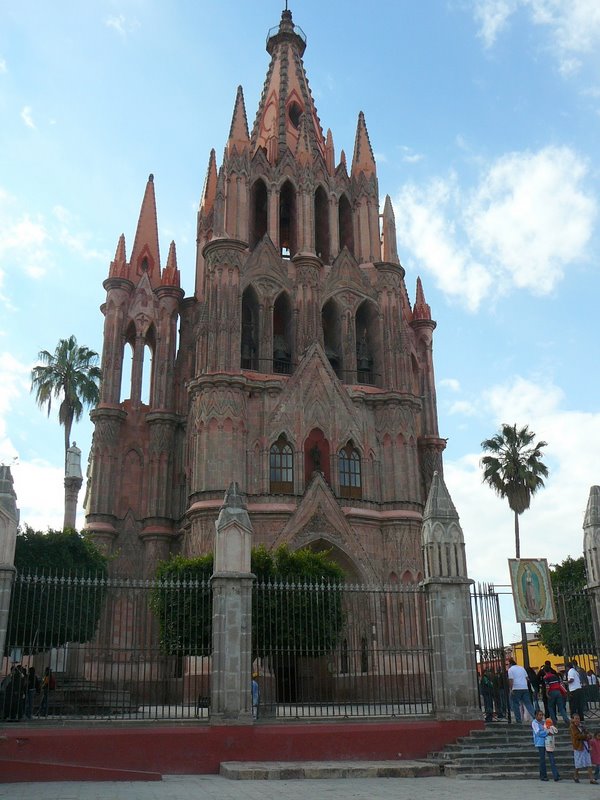
Supposedly Graceland was remodeled to fit the vision of how
Elvis Presley thought rich people lived. La Parroquia's
facade fits Ceferino Gutierrez's vision of how Gothic
cathedrals should look, based upon the postcards that were as
close as he ever got to those great European medieval
structures. Like his fellow visionaries creating
Chartres or Paris's cathedrals, each morning the illiterate
Gutierrez would draw the day's work in the sand in front of
the church and his masons would add what he drew to the
slowly rising tower.
[12]
Kitsch or high art? Does it matter? The facade
works and is loved by the people who live with it. It
gives San Miguel an immediately recognizable icon just as
Paris has its Eiffel Tower, completed nine years after La
Parroquia's addition. (At the time, many Parisian
artists hated the look of Eiffel's monstrosity.)
Remember that anonymous saying: "You don't love a
woman because she is beautiful; she is beautiful because you
love her." Miguelinos love their pink Parroquia and most
tourists do as well.
Note the bells poking through the upper spaces. San
Miguel has at least 87 church bells plus numerous others in
some of the public buildings. Synchronization is
not a core competency of Mexican Colonial towns, so you may
hear these bells ring anytime during the hour. The
Parroquia boasts the loudest bell in town, nicknamed
"Miguel." It's nearly 6 feet tall and is over 8 inches
thick at its rim. All bells are named after saints and
may get a special ringing on their feast day. When all
church bells are rung at once, we have a
repique[50].
If you find this maddening, come to San Miguel on Good
Friday when all bells are silenced to honor Christ's passion
and entombment.
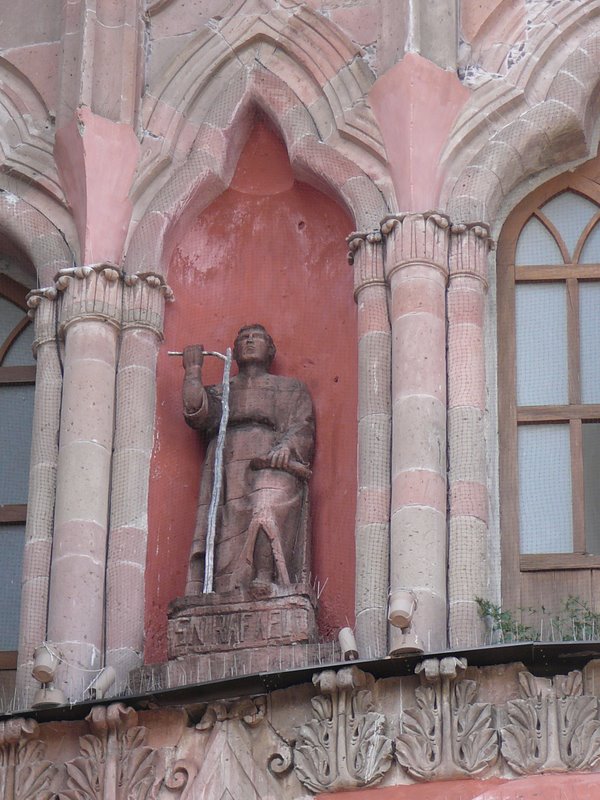
Besides the bells, a few statues protrude through the pink
and tan stones. Gutierrez planned on filling these
niches with such statues as is typical on European Gothic
cathedrals -- but the budget did not allow.
[12]
But let's look at a few statues that were added to the
Parroquia complex later on:
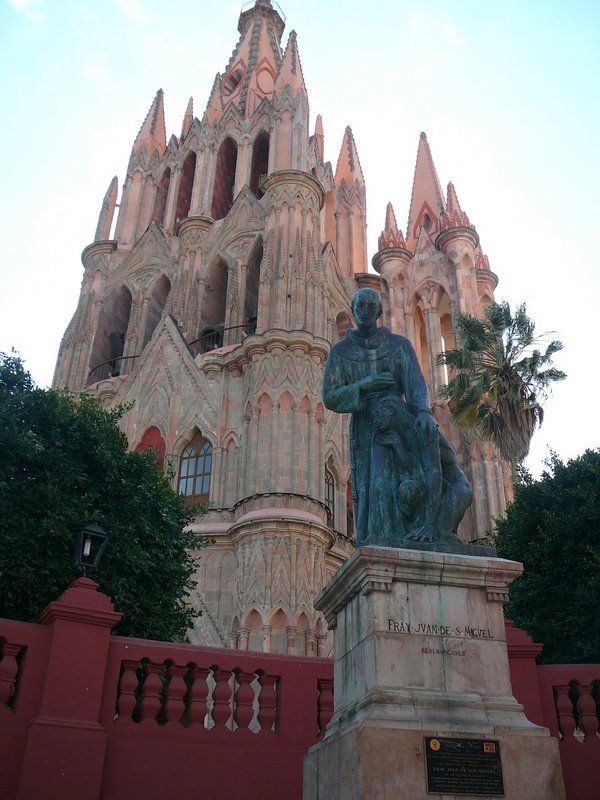
The above bronze was added in 2005 to commemorate the 450th
anniversary of the death of the town founder, the Franciscan
Juan de San Miguel. Here he comforts one of his
indigenous converts. His robe covers the bare feet that
walked the breadth of colonial Mexico in search of lost
souls. [No snickers about the puns, please.] His belt
should show the shell that not only symbolized St. James the
Greater, patron of Spain, but could be put to practical use
to hold baptismal water. Fray Juan did not stay here
long, just long enough to erect a simple mud-and-branch
shelter over the altar and move on.
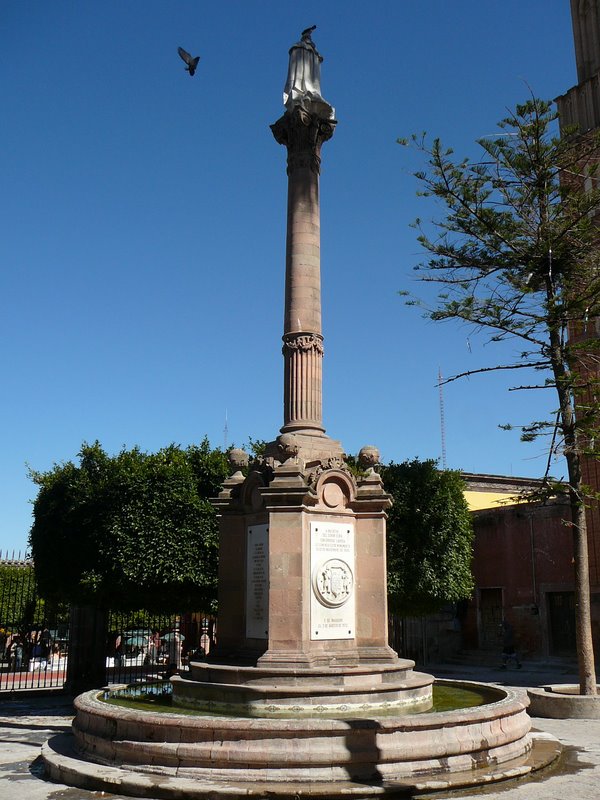
In front of La Parroquia and St. Rafael's (the adjoining
church) rises this monument to the first bishop of Leon,
native Miguelino Jose Maria de Jesus
Diez de Sollano y Davalos. Sollano was the first
native-born Mexican to become a bishop in 1863 -- over 300
years from the time the Spaniards started subduing this land
and 4 decades after Mexico became independent of Spain!
As head of an influential seminary, Sollano made Leon
the center of a revival of St. Thomas's scholastic
philosophy. He also commissioned the building of the
pseudo-Gothic facade on the parish church of his home town.
In both cases, he brought the middle ages to 1880s
central Mexico. A man of a historic first who was
slightly behind his times.
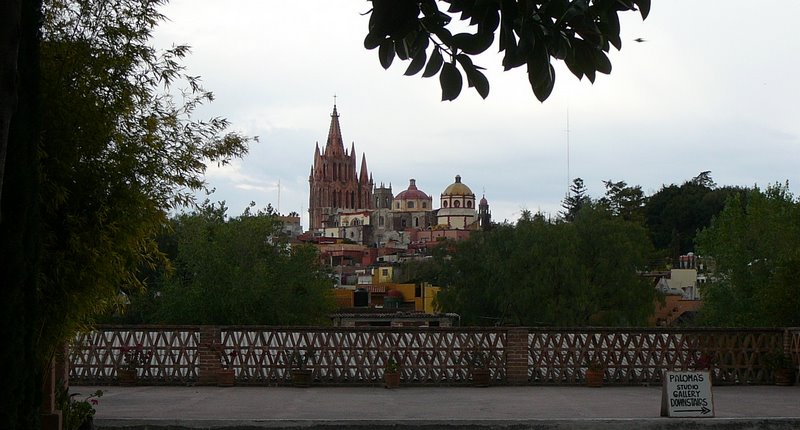
As aging yuppies from Mexico City and US/Canadian expats
move (at least part-time) to San Miguel, local
architects who add to San Miguel exploit any view
of La Parroquia they can get. Here's a dramatic
view from a plaza used for special events such as weddings in
the Allende Institute...
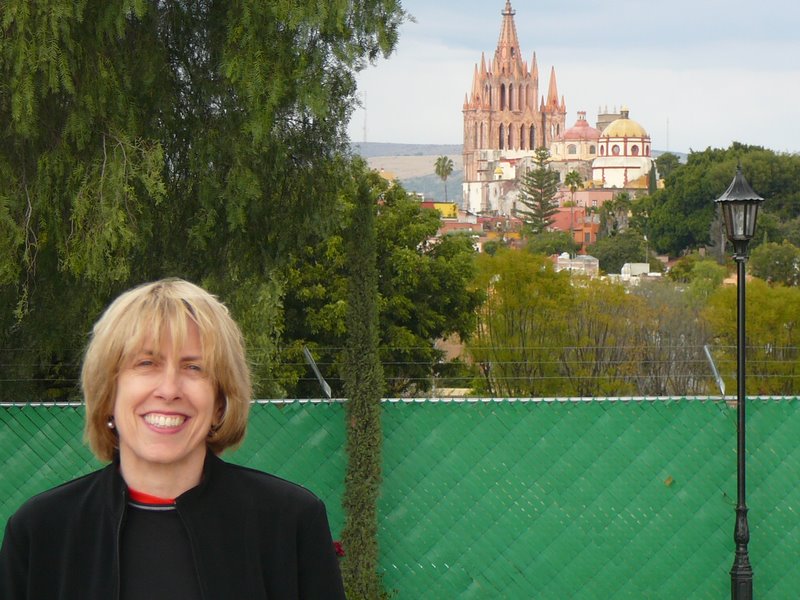
...and another one of a couple works in progress.
Behind the fence will rise a Four Seasons hotel where
you can have a five-star view of the Parroquia. (
Housing prices in Central San Miguel start at around
$200K and go up to $5 million US dollars.) Our star
Jane will return to Houston. Just in front of this spot
is a huge overflow parking area with modern restrooms and
lighting. Progress!
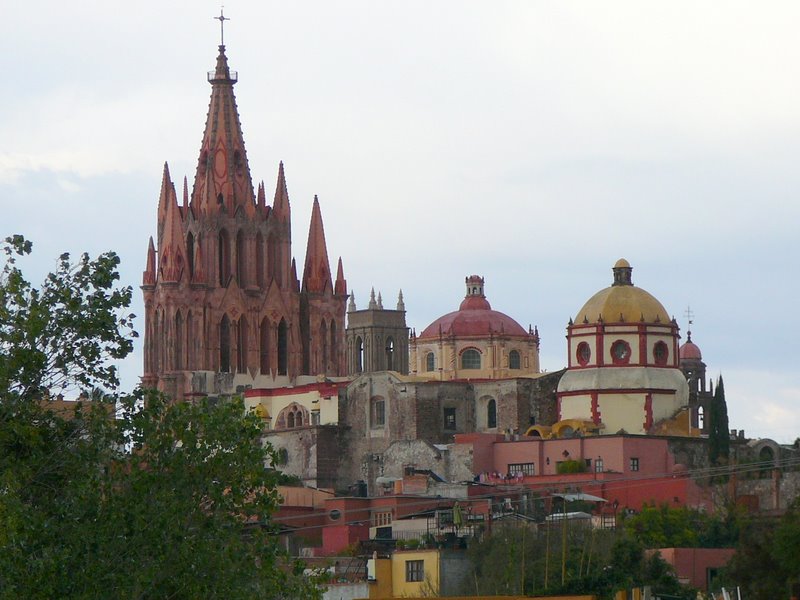
Another exterior shot showing the heterogeneity of this
distinctive building. Medieval cathedrals took as long
to create as La Paroquia but did not diverge this much.
Everything is here including the kitschian sink.
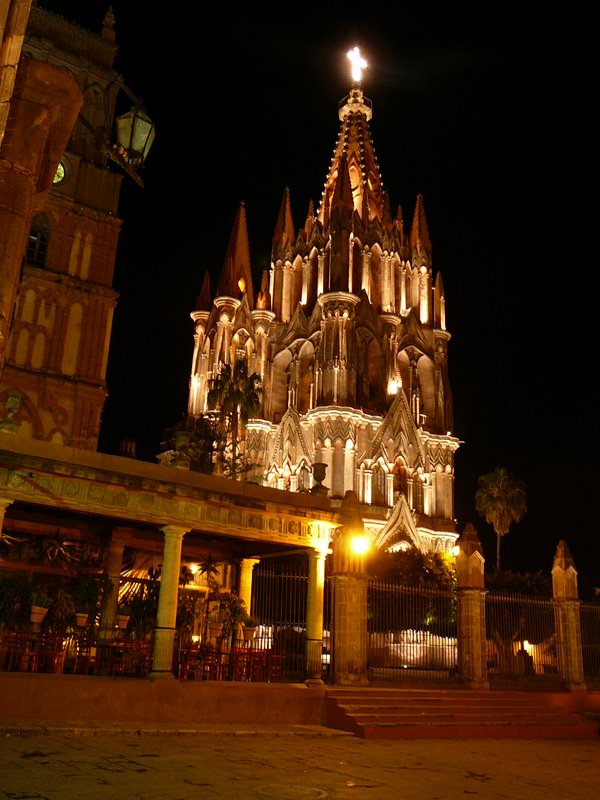
And a final shot of the facade sporting its dramatic night
lighting. In front is an old market now used as a
tourist restaurant. San Miguel's centro can be
a lively place after dark and the well-lit historical
monuments help encourage people to linger.
The Parroquia Interior
Let's now venture inside where the artifacts and art work
provide as much heterogeneity as do the various domes and
towers of the exterior. In general, the layout
follows the classic Latin cross plan. A few places such
as this spot near the left transept even look neo-classic.
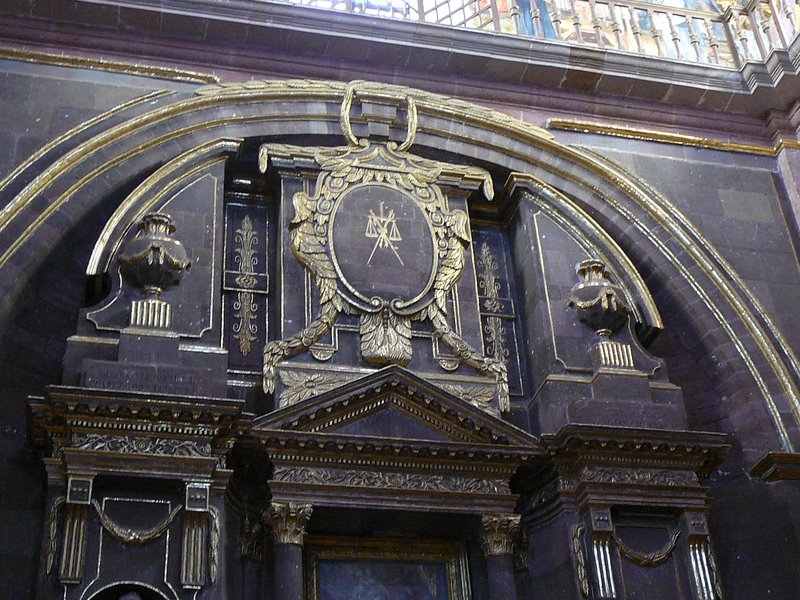
But most of the walls are covered in murals, many of them
done by a parish priest with more devotion than talent.
Apparently he served at La Parroquia for a long
time.
[13]
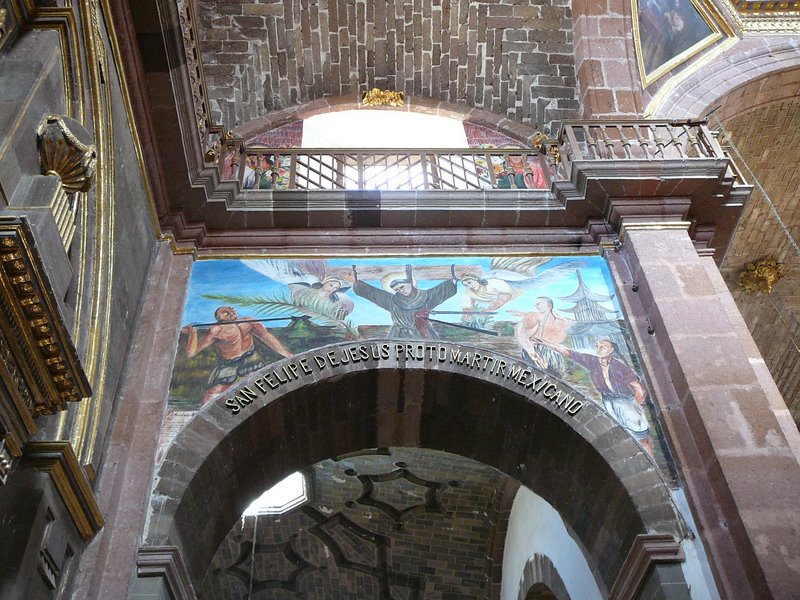
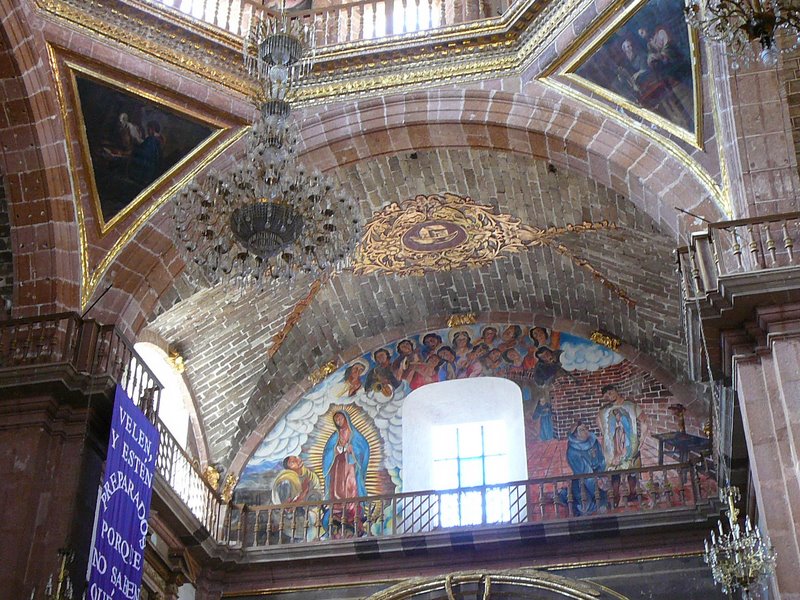
Not even the domes are spared.
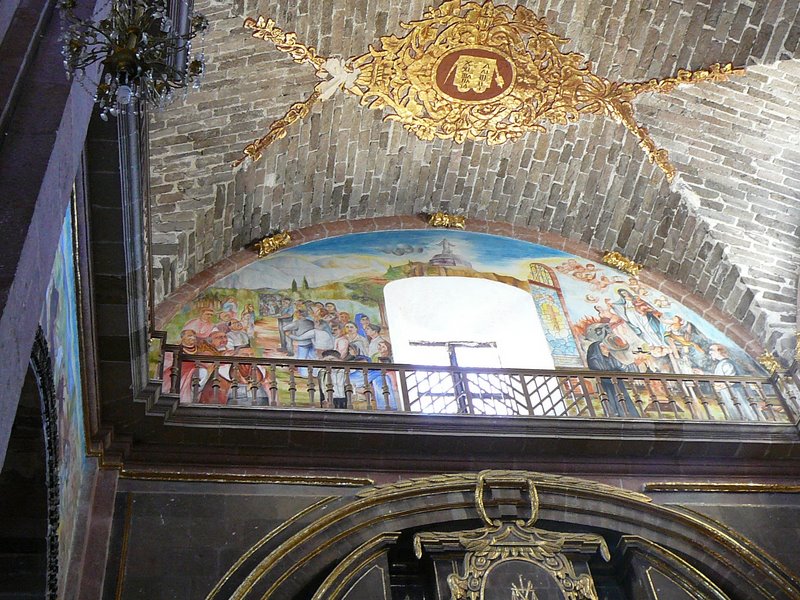
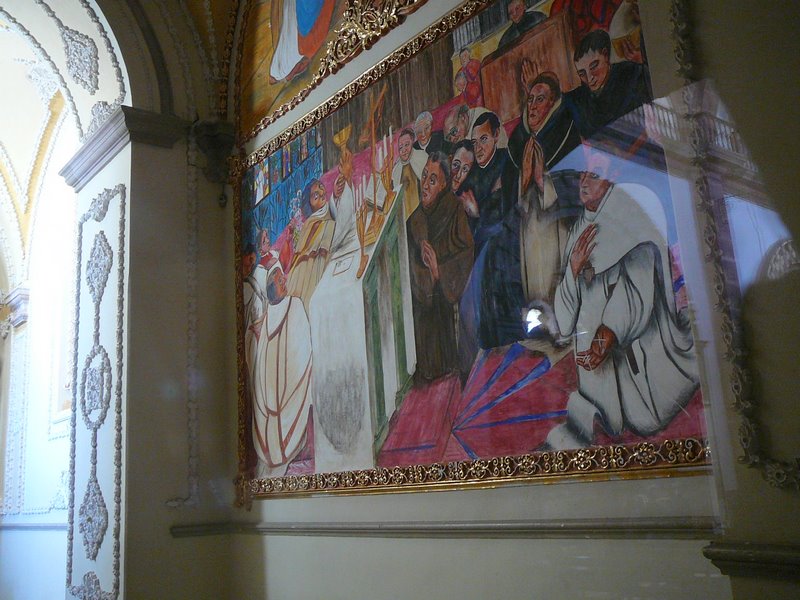
This mural is in the baptismal area. The area was
gated to keep photographers and other riffraff at bay.
Statues
Most of the better statues have been carted off long
ago.
[13] Among
those that remain include this statue of Archangel Michael
(Miguel) above the main altar.
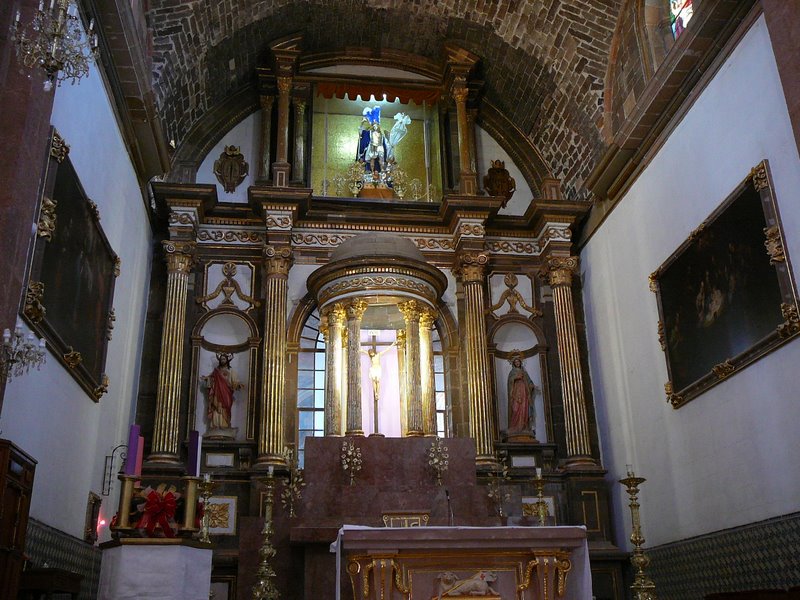
Being an archangel, Michael was in a rare company.
Archangels were pretty much the grand poobahs of the
seven
orders of angels. And
Michael was usually the holy warrior sent to lead the
righteous into battle including against Iran/Persia.
(W, are you listening?) As such, we'd expect a
pretty virile man, perhaps with a 5 o'clock shadow like the
raunchy archangel
Michael portrayed
by John Travolta in the 1996 film of the same name.
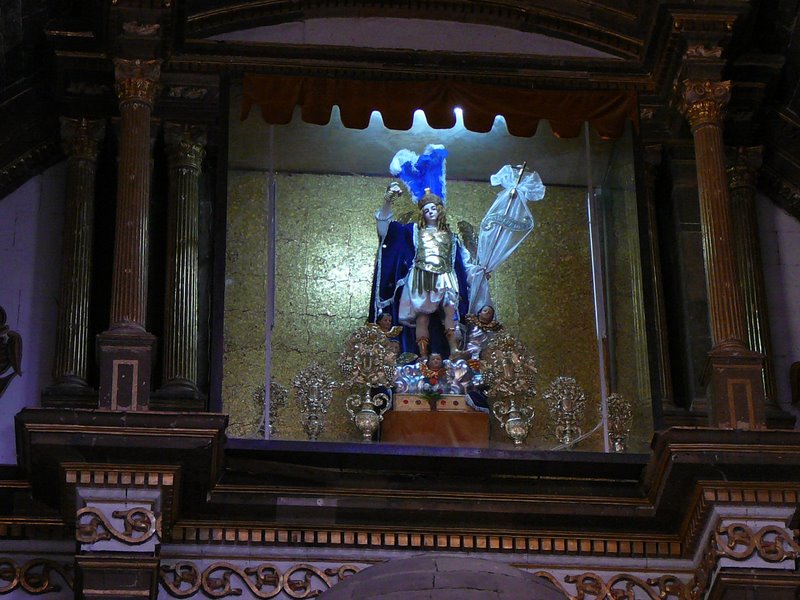
Instead we have an effeminate doll-like statue looking more
like a young cherub rather than a seasoned Archangel warrior.
The reason for this is that the church
forbad artists from providing secondary sexual
characteristics on angels which included
beards.
[14] (How did
that industrial-strength Catholic named Rubens get away with
giving his corpulent
cherubs the
primary sexual characteristic? Don't spare the rod lest
you spoil the art!)
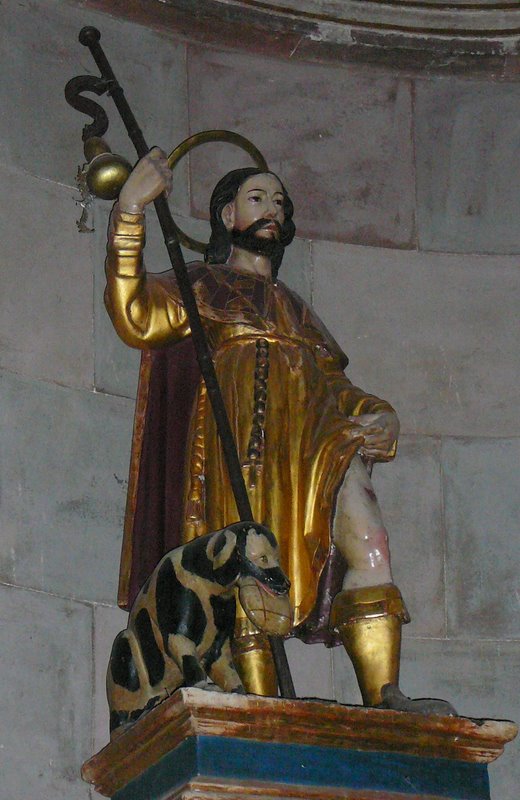
Here's another statue: this one of
St. Roque
(Roch/Rocco) -- known as the plague fighter. The dog,
with a Mexican bolillo in mouth, reminds us how the
saint was fed once he had been expelled from the town where
he had nursed plague victims, only to contract the disease
himself.
[13] Here he
uncovers his thigh to show his plague sores. While the
plague wiped out a third or more of Europe starting in the
14th century, European diseases killed off
95% of the indigenous people in the early days of the
Spanish conquest, giving San Roque much to do. (Modern
scholarship claims Roque probably never existed).
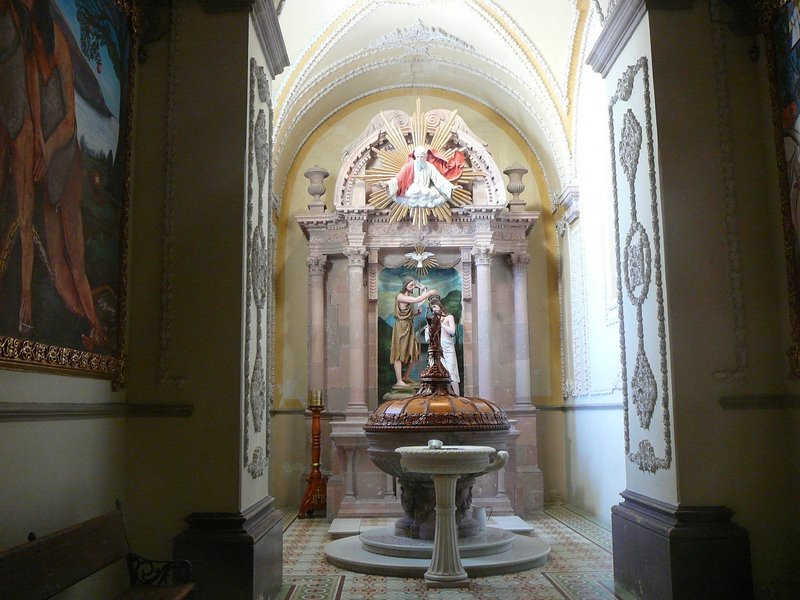
San Roque's statue stands near the entrance to the
Baptistery on the left side of the church. Some of the
heroes of the Mexican war of independence were baptized
here.
[13]
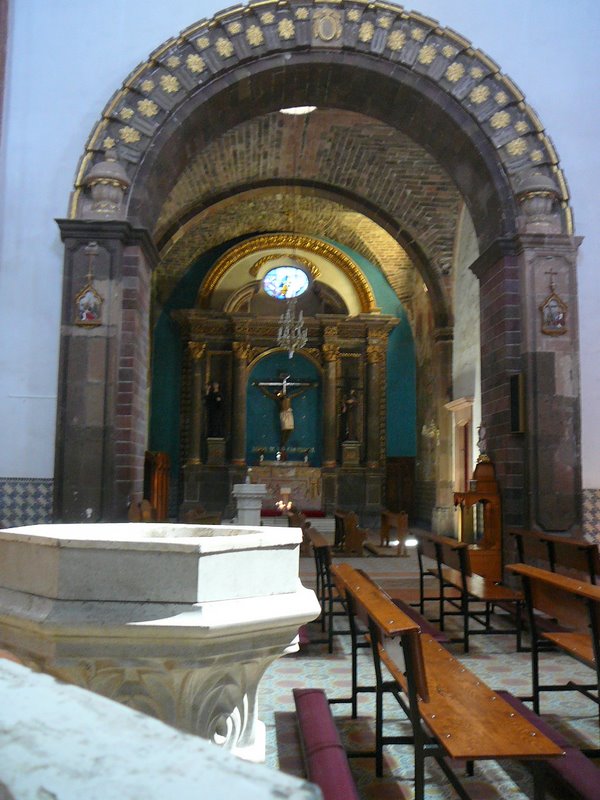
The view down the left transept leads to the last statue we
will discuss: Our Lord of the Conquest, an image fashioned
from the hearts of cornstalks and orchid glue by the
indigenous people of Patzcuaro.
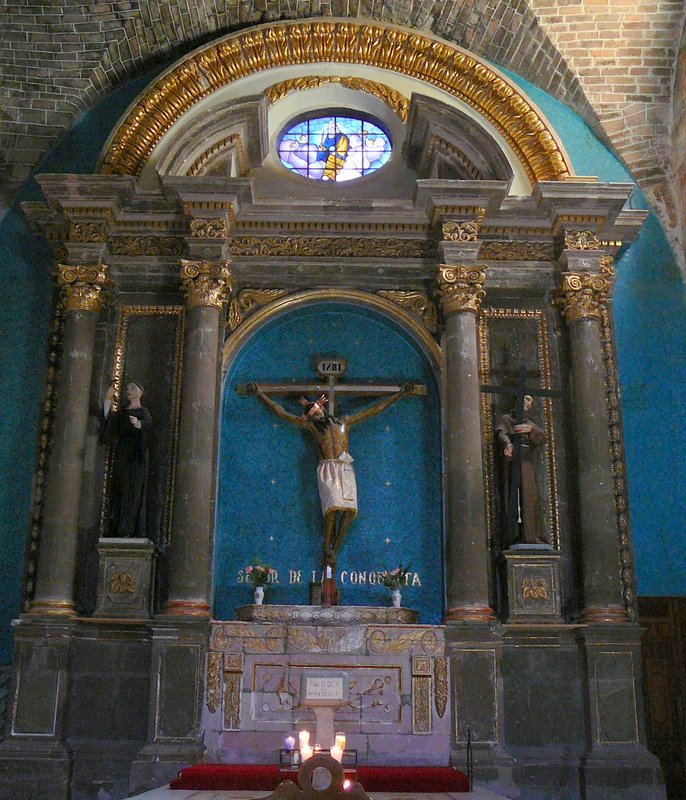
This life-size sculpture is quite light. The two
friars who were bringing it to San Miguel were ambushed and
killed by the Chichimecas, just south of town. The
blood of one of them remains on the statue. Somehow it ended
up here where it is sacred to the
concheros dancers who participate in ancient
(pre-Columbian) ritual dances accompanied by music emanating
from lutes constructed or
armadillo shells.
The Eucharist Chapel -- Capilla del Santisimo
The back of La Parroquia on the left (east) side contains a
small chapel devoted to the adoration of the
Eucharist. The large wall sign reminds visitors in
primitive skeleton letters of the scriptural roots of the
Eucharist from
Matthew 26 -- and tries to keep the tourists out (or at
least respectful).
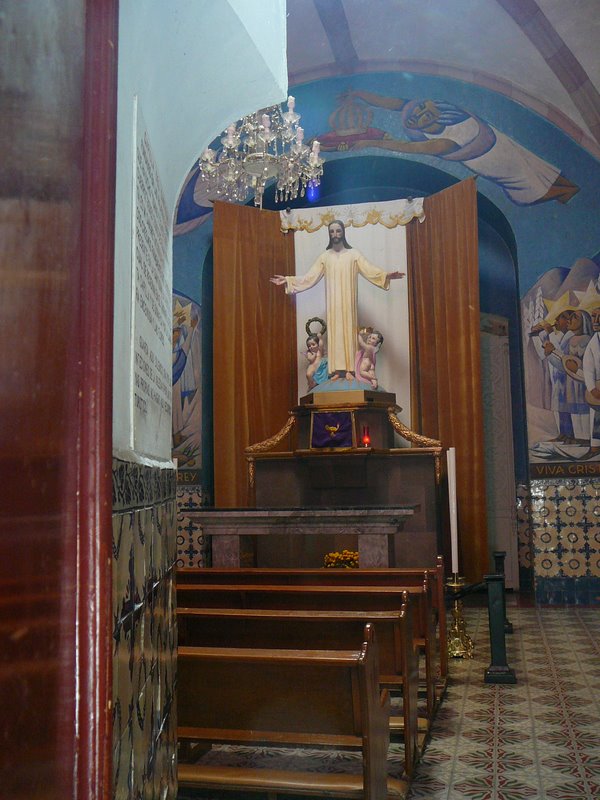
The chapel seems to contain more modern murals that work
together better than the amateur priest's paintings
throughout much of the rest of the interior of La Parroquia.
Maybe it's that eye of God over the barred window on
the left side.
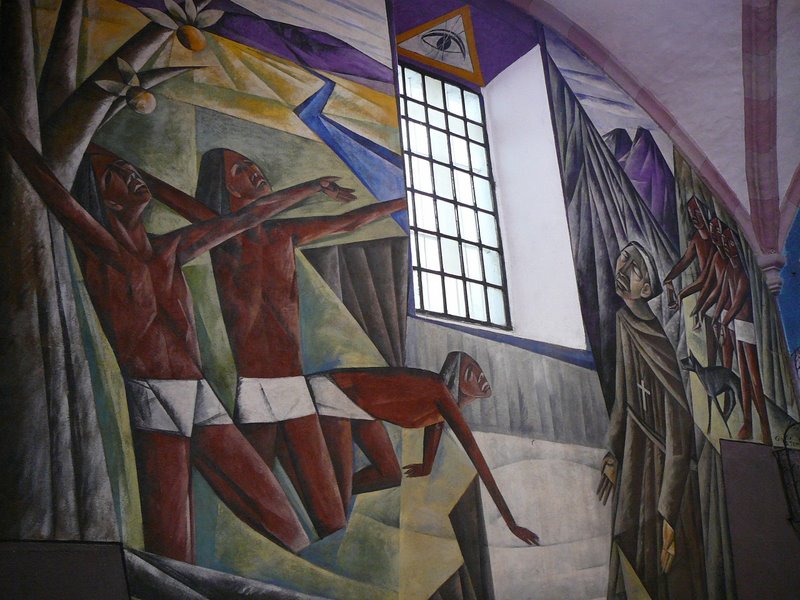
This large mural above is on the left. The one below
is on the front wall to the right of the chapel of Jesus with
his two cherubs.
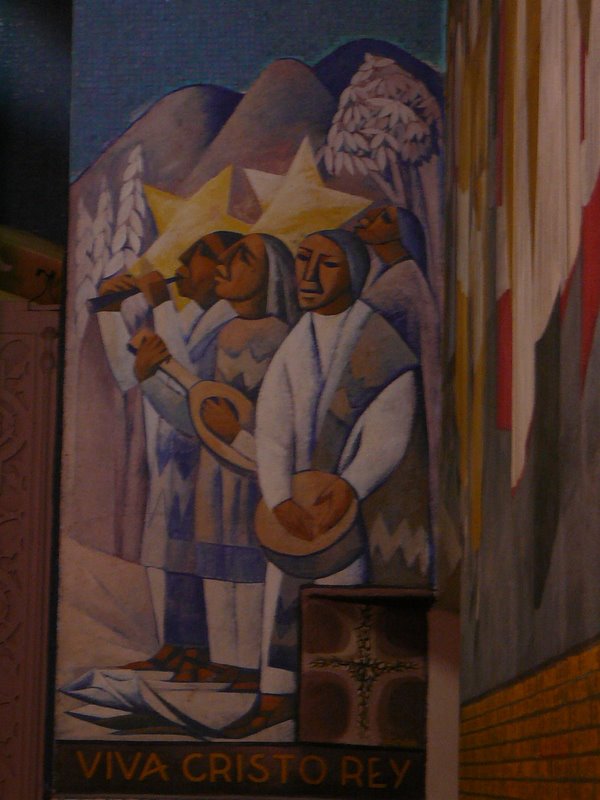
Our musicians seem to be raising a somber song to Christ the
King.
The Crypt
Lucky visitors can find their way down to the usually locked
crypt below the main altar. Of the three major
architects who created or elaborated on La Parroquia, the
designer of this space has been most honored by
history:
Francisco Eduardo Tresguerras.
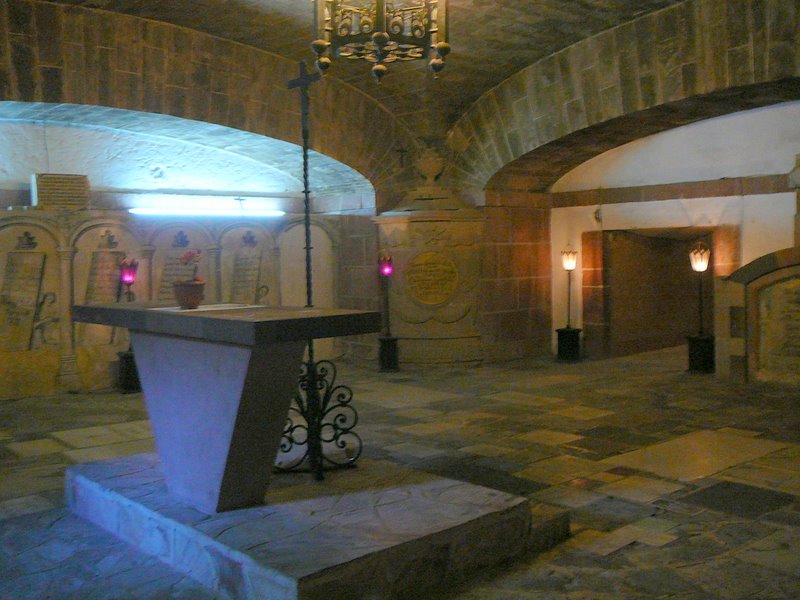
Tresguerras (1759-1833) was a famous not only as an
architect but also as a painter and sculptor/wood carver.
He learned architecture through the literature; like
the untrained Ceferino Gutierrez who created La Parroquia's
iconic Gothesque pink tower, Tresguerras never went to Europe
to study its wonderful cathedrals
in situ.
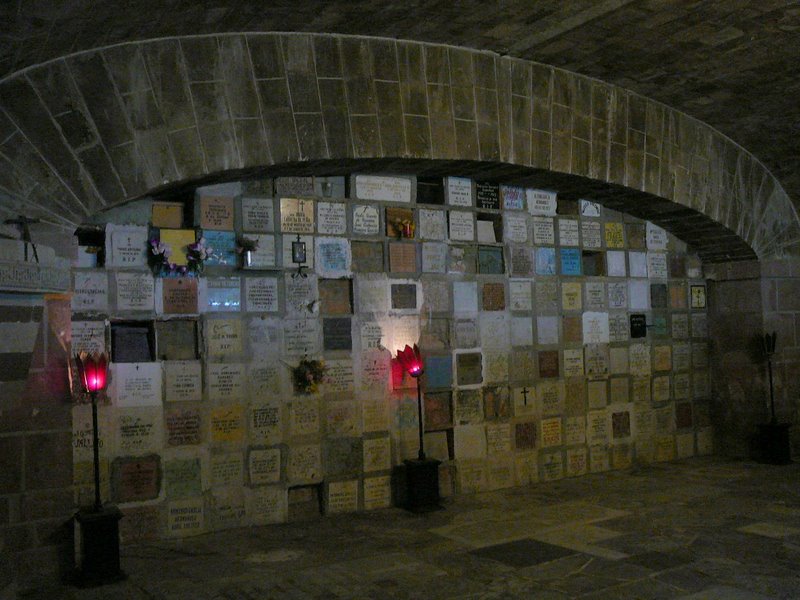
Tresguerras was born in the nearby city of Celaya where
his neo-classic masterpiece, the church of El Carmen still
stands. But lets anachronistically call him a
Renaissance man since he also painted the frescoes in this
church, wrote devotionals as well as satires and poetry.
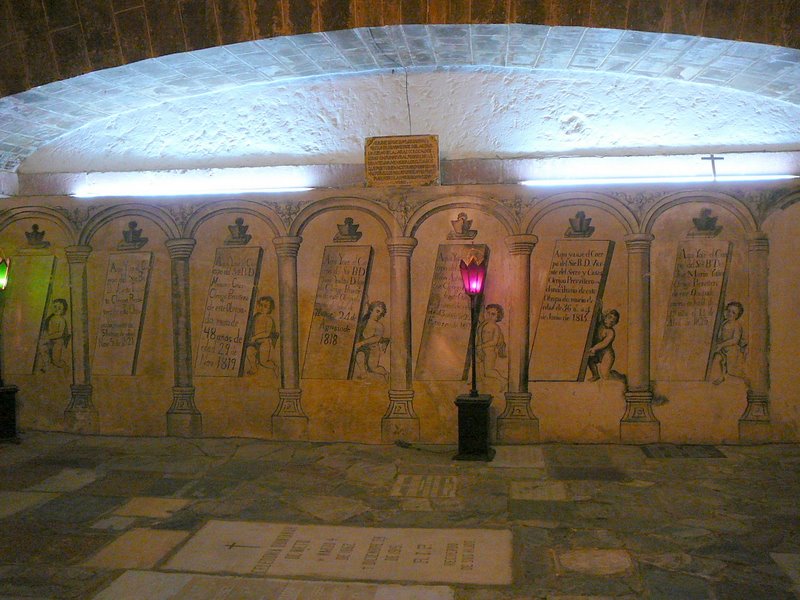
In addition to the architecture, Tresguerras did these
monochrome murals
Soon after the war of independence began in
1811, Tresguerras was arrested for being in favor of the
revolutionaries. Fortunately, he had been conscripted
to "save" a nearby (and quite different) San Miguel church
called San Francisco long before. (Learn more about
that church
by clicking here).
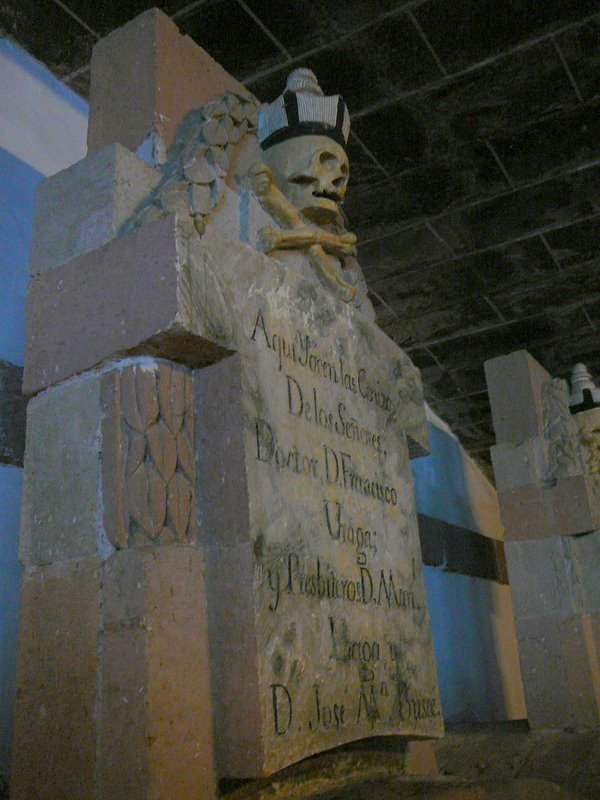
This crypt contains the bones of one of those
revolutionaries: Felipe Gonzalez (not the 20th century
Spanish socialist but a conspirator with Ignacio Allende as
they met in a nearby house and plotted).
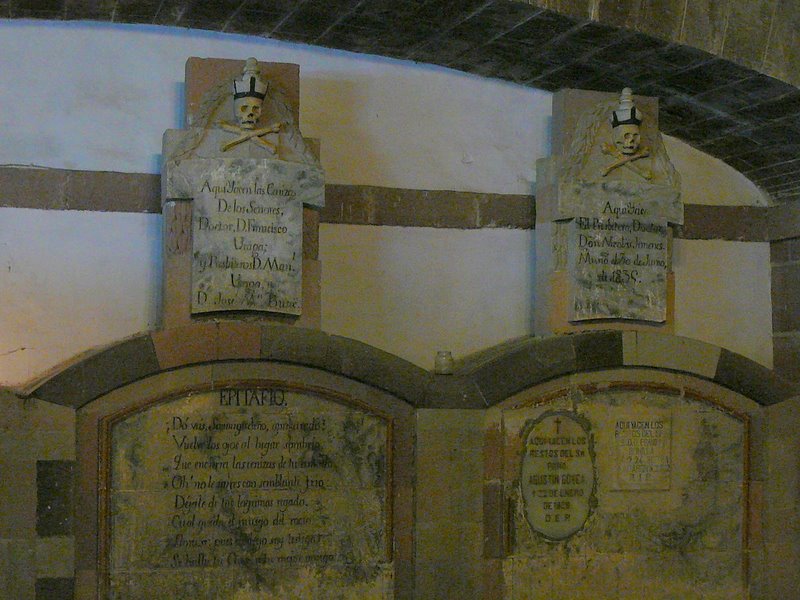
The place also houses the body (but not the heart) of
General Anastasio Bustamente, president of the finally
independent Mexico who retired to San Miguel and died here in
1853
[111]
after his several bouts of power and exile. He first
came to fame as a royalist general, trying to suppress the
revolution. Once the revolution was assured, he had a
change of heart and joined the rebels, rescuing the four
heads (including Allende and Hildago) that had been exposed
to the elements in cages in nearby Guanajuato for a decade.
Graves make for ironic companionship
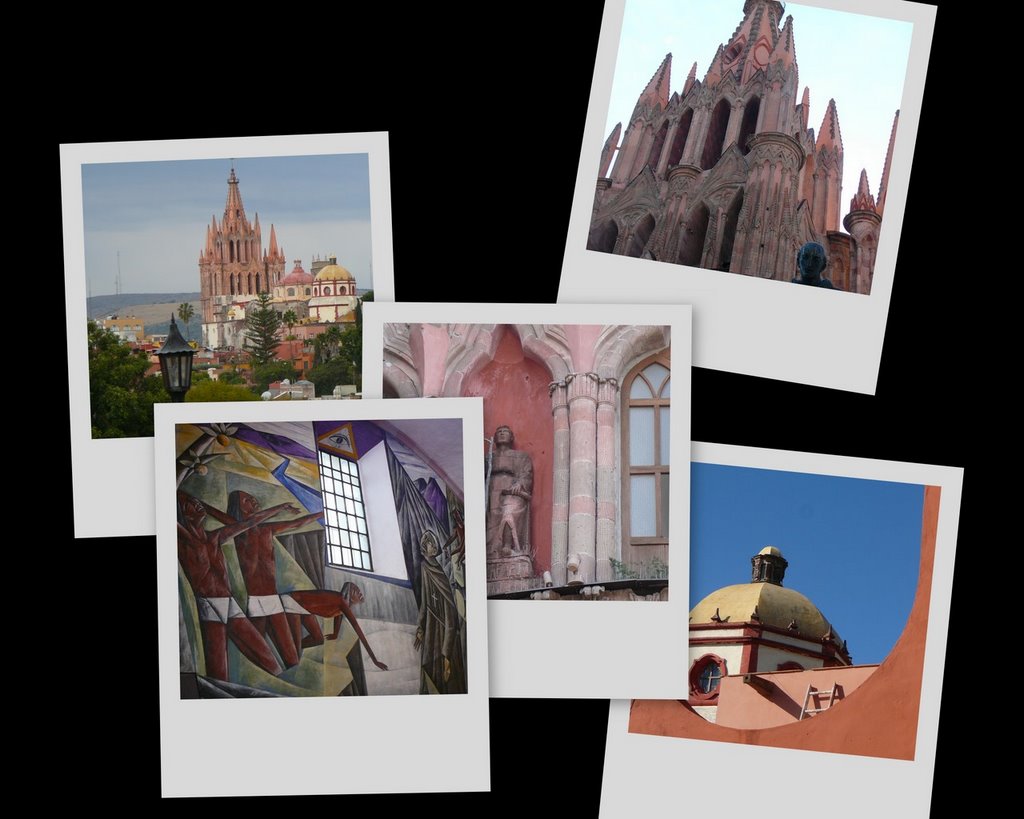




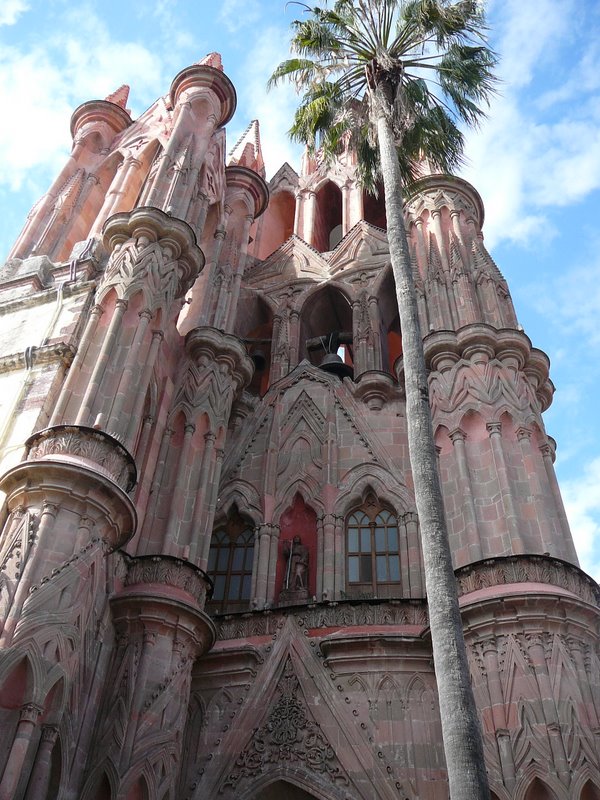


























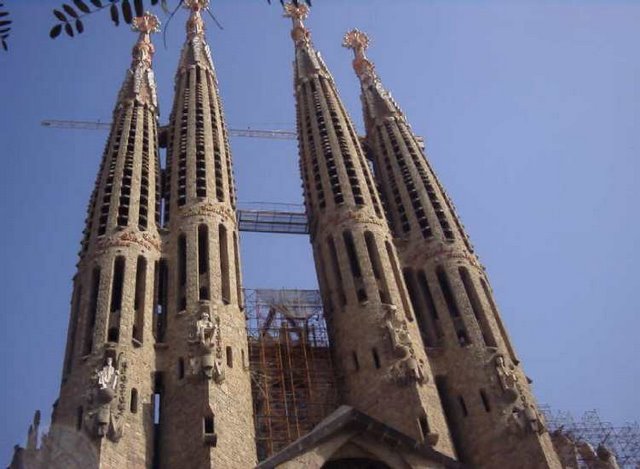 Above is another view of La Parroquia. Actually not.
It's the work of one of the most distinctive 20th
century architects, the well-educated Catalan
Antonio Gaudí. He started his neo-Gothic Sagrada Familia cathedral in OLD Spain in
1882, about the same time that San Miguel's signature
church was getting its new facade. Dick visited the
Barcelona building site in October of 2001 and found it
still unfinished. (He also saw another work-in-progress
visiting the building site, a guy named Bill Clinton.
To see those pictures and a bit of commentary, click here.) If we moved this
church to Mexico, would it suddenly become
kitsch?
Above is another view of La Parroquia. Actually not.
It's the work of one of the most distinctive 20th
century architects, the well-educated Catalan
Antonio Gaudí. He started his neo-Gothic Sagrada Familia cathedral in OLD Spain in
1882, about the same time that San Miguel's signature
church was getting its new facade. Dick visited the
Barcelona building site in October of 2001 and found it
still unfinished. (He also saw another work-in-progress
visiting the building site, a guy named Bill Clinton.
To see those pictures and a bit of commentary, click here.) If we moved this
church to Mexico, would it suddenly become
kitsch?